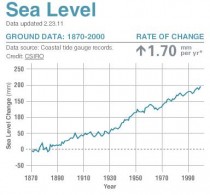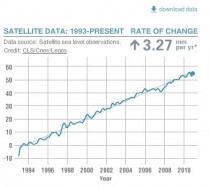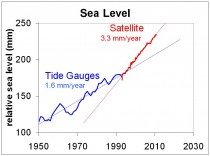Jun 05, 2011
Climate alarm not justified, say experts at Ottawa Conference
By Tom Harris
Anyone not already familiar with the stance of geologists towards the climate scare would have been shocked by last week’s conference at the University of Ottawa. In contrast to most environmental science meetings, climate skepticism was the norm among the thousand geoscientists from Canada, the United States and other countries who took part in GAC-MAC 2011 (the Joint Annual Meeting of the Geological Association of Canada, the Mineralogical Association of Canada, the Society of Economic Geologists and the Society for Geology Applied to Mineral Deposits).
The lead symposium of the conference, “Earth climate: past, present, future”, was especially revealing. Chaired by University of Toronto geology professor Dr. Andrew Miall, the session description starts: “The scientific debate about climate change is far from over. Some of the projections of climate change and its consequences contained in the 2007 Report of the Intergovernmental Panel on Climate Change (IPCC) have been called into question. This symposium will address some of these issues and present a geological perspective on the scientific debate.”
Talk after talk at GAC-MAC were from “climate rationalists”, defined by Australian geology Professor Bob Carter of James Cook University as “persons who are critical (on balanced scientific grounds) of the IPCC’s alarmism, ...reflecting the primacy that such persons give to empirical data and thinking. The climate rationalist approach contrasts markedly with the untestable worlds of computer virtual reality that so many climate alarmists now inhabit.”
Leading off the GAC-MAC climate symposium was fellow Australian, Dr. Ian Plimer, Professor in the School of Civil, Environmental and Mining Engineering at the University of Adelaide. In a keynote presentation entitled “Human-induced climate change: Why I am skeptical”, Plimer completely dismantled the greenhouse gas-driven climate change hypothesis. He showed how climate has varied naturally on all time scales and how recent changes are not unusual. Plimer explained the lack of meaningful correlation between the greenhouse gas carbon dioxide (CO2) and planetary warming and cooling and how “climate models throw no new light on climate processes.” He concluded, “Pollution kills, CO2 is plant food, H2O vapour is the main greenhouse gas.... Humans can adapt to future changes.”
Following Plimer were 14 other climate presentations by leading geoscientists. Dr. Henrik Svensmark of the National Space Institute of the Danish Technical University spoke about how cosmic ray variations in the atmosphere are influencing climate by changing the microphysics of clouds. University of Ottawa emeritus professor Ján Veizer presented his research describing the role of the sun and water vapour on CO2 and climate change. Calgary geologist Norm Kalmanovitch detailed his findings that human-caused global warming theories are not supported by observational data. Carleton University researcher Dr. Hafida El Bilali showed how her work with paleoclimatologist Professor Tim Patterson revealed that variations in the output of the sun have had a major influence on regional climate for the past nine millennia.
And so it continued. Not a single presentation in the symposium supported the IPCC’s human-caused dangerous global warming hypothesis. In the discussion period following the talks, climate rationalists decried the lack of media or public attention to the symposium or their research findings. In the exhibit hall, few exhibiters seemed interested in human-caused global warming and the catastrophic messages that so overwhelm delegates at other climate-related conferences were nowhere to be found.
Where were the scientist supporters of climate alarmism? Did they not know that climate was a major focus of this, the largest geologic conference in the country?
They knew. According to Miall, even though some were directly invited, they either refused to participate or ignored the invitation. “The people on the IPCC side will not debate,” explained Miall. “Anything that’s brought up that they disagree with they say has been dealt with and is no longer considered important or is a minor effect. This is often quite wrong.”
In front of the public lecture at last June’s Canadian Meteorological and Ocean Society (CMOS)/Canadian Geophysical Union (CGU) Congress in Ottawa, the prospect of a public debate between the two sides was put to keynote speaker Dr. Warwick Vincent of Laval University. Vincent was supportive, as was a CMOS past president. Yet, on later approaching CMOS executives and directors about taking the steps necessary to arrange such a public dialog, the responses were negative to the point of abuse and nothing transpired.
Suggestions of a proper climate science debate have been ignored by CMOS for many years. For example, in the December 1997 CMOS Bulletin long-time CMOS member Dr. Madhav Khandekar, then just retired from his Research Scientist position at Environment Canada, pushed for an open dialog in his article “Global warming & climate change in Canada: A need for an open scientific debate” CMOS executives completely ignored the piece.
In 1990, Dr. Tad Murty, then Senior Research Scientist in DFO’s Institute of Ocean Sciences and chairman of the scientific committee for that year’s CMOS congress, tried to arrange it so that two of the four invited speakers were climate rationalists. However, the other nine scientists on the scientific committee vetoed the idea and it died.
Going into next week’s congress in Victoria, CMOS, like many organizations of its ilk, maintains a rigid stance of climate catastrophilia. The congress includes sessions described with clearly mistaken statements such as “Recent research has highlighted the irreversibility of CO2-induced climate change on centennial timescales ....” Other, less extreme but also unjustified assertions abound: “It has become widely recognized that under a changing climate, the frequency and intensity of meteorological/hydrological extreme events and associated damage costs would more likely increase in the 21st century.”
The narrow-mindedness of CMOS and other climate alarmists matters because they have the ear of mass media, most of whom uncritically report on CMOS’ public statements that the science is settled and debate unnecessary. As a consequence, the public are highly influenced and seriously flawed CMOS messages are incorporated into government pronouncements and actions.
Miall maintains that the views of geoscientists are crucial for a proper understanding of climate. Consequently, uncomfortable though it may be for these experts, society needs them to speak out forcefully. Otherwise, the climate alarm, its science failing but the movement still powerful, will stagger on, leading society to waste billions of dollars and destroy thousands of jobs. It is time to put the climate change zombie out of its misery.
Jun 05, 2011
Warming Alarmists Lose Yet Another Debate
In celebration of World Environment Day, the Queensland Division of the Property Council of Australia convened a breakfast meeting last Friday morning (June 3rd) to debate the topic “Australia needs a carbon tax”.
Leading speaker for the motion was Mr. Matthew Bell (Climate Change & Sustainability Services, Ernst & Young), supported by Ms. Kellie Caught (Acting Head of Climate Change, WWF Australia) and Mr. Kirby Anderson (Policy Leader, Energy Infrastructure, General Electric).
Speaking against the motion were Mr. Michael Matusik (Director, Matusik Property Insights), supported by Mr. John Humphreys (Director, Human Capital Project, University of Queensland) and Professor Bob Carter (James Cook University and Institute of Public Affairs).
The audience of about 150 persons were treated to some pointed exchanges, with the team speaking for the motion concentrating rather more on the science, and their opponents almost exclusively on the economics and cost:benefit analysis of the introduction of a carbon tax.
One compelling argument was the observation that to introduce a carbon tax of $25/tonne of carbon dioxide would cost around $100 billion by 2020, for a notional benefit of 0.0002C (two ten thousandths of a degree) of warming averted.
The opponents of the tax were awarded a clear win, on rendered applause, by debate Chairman Mr Mark Ludlow (Australian Financial Review).
Jun 03, 2011
Union of Concerned Scientists caught in yet another lie…about warming, ozone and health risks
By Joseph D’Aleo
Like their allies in the universities and media, the Union of Concerned Scientists have taken both sides of many issues in recent years - decreasing snow/increasing snow, warm winters/cold winters, decreasing western snowpack and water supply/increasing western snowpack and water supply, increasing drought/increasing flooding etc. Now they’re health experts. They get far more credibility in the media than they deserve. Take for example today’s USATODAY where again their story is wrong an every count.
USA Today reports: “Left unchecked, climate change could increase breathing problems and health costs by exacerbating ground-level ozone, warns a report Thursday by the Union of Concerned Scientists. Higher ozone levels could trigger 2.8 million additional serious respiratory illnesses and 944,000 extra missed school days in the United States in 2020 that could cost $5.4 billion, according to the peer-reviewed report by the Cambridge, Mass.-based environmental group. ‘Even a small increase in ozone due to a warmer climate would have a significant impact on public health,’ said report co-author and UCS public health expert Liz Perera in announcing the findings. ‘It would mean more asthma attacks, respiratory illnesses, emergency room trips and premature deaths.’ The most vulnerable U.S. states? The study used a mapping model by the Environmental Protection Agency to calculate national impacts and rank the 10 states most likely to be harmed in 2020. In terms of costs, the research found that California would be hit hardest, followed by Texas, New York, Pennsylvania, Illinois, Ohio, Michigan, North Carolina, New Jersey and Virginia. It said these states have large numbers of urban residents, children and seniors as well as high levels of nitrogen oxides and VOC (volatile organic compound) emissions from vehicles and power plants...If global warming emissions continue to increase, the study estimates that average U.S. temperatures could rise 3 to 5.5 F by 2050 and result in about 11.8 million additional serious respiratory illnesses, 29,600 more infant and senior hospitalizations and 4.1 million additional lost school days in 2050. Yet it says these health impacts could be cut about 70% if emissions decline and temperatures rise 2 to 4 F instead. “The good news is we can address both ozone pollution and climate change by cutting fossil fuel emissions,’ Todd Sanford, a UCS climate scientist and report co-author, said in a statement.”
CCM and former state climatologist George Taylor responded: Higher temperatures do not cause higher ozone. Ozone in the atmosphere is produced mainly from a reaction between sunlight and nitrogen dioxide (NO2). So sunny summer days end up being the warmest AND the highest in ozone, but it’s the SUN, not the air temperature, that causes the ozone to rise. Joel Schwartz and I wrote a report called Air Quality False Alarm, some years ago addressing this issue. Excerpt:
During the last 30 years, urban temperatures have risen, yet ozone levels have declined. Urban temperatures have risen an average of 1-3 degrees Fahrenheit (F) during the last 30 years, yet ozone levels have fallen (National Climatic Data Center 2004). The temperature increase is due mainly to the urban heat island effect, rather than global climate change, as demonstrated by the fact that rural temperatures have risen more slowly than urban. For
example, de Laat and Maurellis (2004) state “the ‘real’ global mean surface temperature trend is very likely to be considerably smaller than the temperature trend in the CRU [Hadley Center/Climate Research Unit global data set] data.” Other researchers have published similar results (see e.g., Karl, Diaz et al. (1988)).
Nevertheless, despite increasing urban temperatures, the average number of exceedances per year of EPA’s 8-hour ozone standard declined 75 percent from 1975 to 2004, while exceedances of the 1-hour standard declined 95 percent. Figure 1 shows the trend in the national-average number of days per year with ozone exceeding EPA’s 1-hour and 8-hour ozone standards for all ozone monitoring locations in the U.S. The graph also includes the national average trend in peak daily summer temperatures in the U.S. from 1975 to 2004. Note the large variation in 8-hour ozone levels from year to year. These short-term variations are due to differences in weather from year to year, including not only temperature, but rain, wind, and other meteorological ariables. Superimposed on these short-term variations is a long-term decline in ozone exceedance days due to ongoing reductions in ozone-forming emissions.
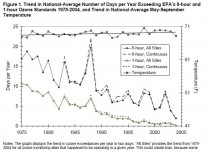
Enlarged.
Icecap Note: The other part of the UCS story that fails is the claim of warming. Here in the US, temperatures have declined the last decade as the solar activity has declined and oceans begun cooling. The winter cooling is most significant.
Here is the decadal trend of temperatures in the United States first annual:
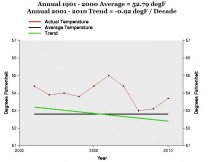
Enlarged.
then winter:
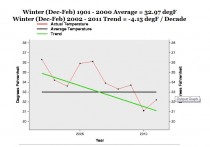
Enlarged.
When will the media stop thinking of the UCS as real scientists with real concerns and recognize they are an enviromental advocacy group much like the WWF, Greenpeace, EDF?
Jun 01, 2011
Offshore Drilling? Obama Says Nil baby Nil
By Art Horn
Drill baby drill has been a frequent rallying cry to inspire America to drill for oil in its offshore waters. This action would free us from energy sources that are unstable and unpredictable. Free market speculation uses this instability to drive up the price of petroleum. The Obama administration is dead set against allowing any offshore drilling. Instead of “Drill baby drill” his policy is “Nil baby nil”. The truth is that president Obama is trying to force an energy production revolution in America with no real estimate of what collateral damage may result from its attempted implementation. The main stream news media has given Obama a complete free pass on this issue.
Right now 98% of America’s off shore oil reserves are off limits to drilling. This moratorium on domestic energy production is just one of the weapons in the energy revolution being spearheaded by Energy Secretary Steven Chu. As President Obama’s right hand man, Chu is also doing everything possible to limit production of our vast resources here at home so that the so called “renewables” become more financially attractive to investors. In September of 2008 Chu said “Somehow we have to figure out how to boost the price of gasoline to the levels in Europe,” Gas prices in Europe are in the range of $7.50 to $9.50 dollars a gallon. On December 10th, 2010 Interior Secretary Ken Salazar announced a new moratorium on offshore drilling, effective for seven years! One of the main strategies is to make extremely expensive wind and solar energy more attractive by driving up the cost of gas. This administration has no intention of allowing oil companies to find more oil offshore that could short circuit their plans.
In April the EPA was handed a convincing defeat. The House voted 255 to 172 with 5 voting present to pass House Resolution 910 which is “To amend the Clean Air Act to prohibit the Administrator of the Environmental Protection Agency from promulgating any regulation concerning, taking action relating to, or taking into consideration the emission of a greenhouse gas to address climate change, and for other purposes.” Be very clear that the Obama administration has no intention of taking this defeat lying down. When the president realized that his first choice to control carbon dioxide emissions was dead he responded with “Cap and Trade was just one way of skinning the cat, it’s was not the only way.” The president has every intention of finding that other way.
One of those other ways to skin the cat is to sabotage the efforts of American oil companies in their attempt to increase domestic supplies of energy. This under the radar attack will be spearheaded by the combined forces of two federal agencies. The first is a new agency that the Obama administration created after the BP oil spill. It replaced the Minerals Management Service. It has the imposing big brother sounding title of the Bureau of Ocean Energy Management, Regulation and Enforcement (BOEMRE). Not the friendliest sounding agency title for any company looking to explore for offshore oil I’d say. I think it’s safe to say that the word “Regulation” in the agency name is code for interference and obstruction with any method possible.
The second federal agency in the war against offshore exploration by our oil companies is the National Oceanic and Atmospheric Administration (NOAA). This agency is the official home of the government’s oceanographers. After recommendations from a presidential commission the two agencies have signed a memorandum of understanding. This memorandum is more code from the administration. The real message from the memorandum is that these are marching orders from the president to get together and defeat the enemy, big oil and its dirty carbon dioxide polluting ways. The presidential commission noted that under previous administrations the NOAA oceanographers had little say in how federal leases were auctioned. The obvious intent now is for that to change.
The anti-drilling message from Washington is confusing and inconsistent making future exploration risky and therefore more unlikely. Recently Shell Oil scuttled its attempts to develop oil fields in the arctic after the EPA came up with absurd complaints about possible air pollution in a tiny village 70 miles from the proposed drilling site. Shell has spent $2 billion on permits and $4 billion dollars exploring the area north of Alaska where the US Geological Survey says there could be 27 billion barrels of oil. That is 2.5 times as much oil as has flowed down the Alaska Pipe Line since 1981. But hold on! Now the EPA’s Chief of Air Programs, Gina McCarthy says “I believe that we are very close to a strong permit that will allow them to have actually three drilling operations going on in the Arctic in a way that is protective of public health and consistent with current law.” It’s hard to know if this kind of back and forth jockeying is just incompetence or a planned out strategy to make oil companies throw up their arms and just give up. In either case the result is to make future exploration less likely due to delays and therefore higher costs.
By using this new two pronged attack strategy combining the strengths of the Bureau of Ocean Energy Management, Regulation and Enforcement and the National Oceanic and Atmospheric Administration, the president hopes to look good for the upcoming election by allowing consideration of offshore drilling. He will be able to say in speeches that he is exploring for oil offshore to cut America’s dependence on imported oil. This will be a total smoke screen. Here is a perfect example of this deceit.
At a recent hearing before the House Oversight and Government Reform Committee, EPA administrator Lisa Jackson said “Last year American oil production reached its highest level since 2003.” Committee Chairman Darrell Issa R-California responded with “It takes five years at best case...from the beginning of the process to drilling production. So isn’t all the credit for this new peak in the previous administration? Exactly! Attempting to take credit for what the Bush administration actually did exposes what the current administration has done to develop our energy reserves at home, nothing. This deceit also reveals their true intentions as well. They have absolutely no intention of developing offshore oil.
With that kind of agenda exposed to the light of day how will the combined forces of the Bureau of Ocean Energy Management, Regulation and Enforcement and the National Oceanic and Atmospheric Administration stop oil companies from developing offshore resources? The job of these two agencies will be to work day and night for as long as it takes to delay, obstruct and stop anything that might actually bring oil up from the ocean floor. They will commission studies that will take months if not years to complete. Then they will write reports that will show the detrimental impacts of offshore drilling on a wide variety of marine life ranging from the microscopic to whales. Then these studies will be sent to Congress where we will then have hearings as to what the studies show and why we should delay any offshore drilling until more studies can be completed. Remember “Cap and Trade was just one way of skinning the cat, it’s was not the only way.” Far from “Drill baby drill” it will be “Nil baby Nil”.
|

